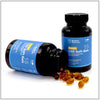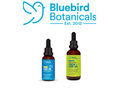Full-Spectrum vs. Broad-Spectrum CBD: What’s the Difference?

The world of CBD products is complex and ever-changing. New regulations, new innovations, and...new types of CBD?
We’re talking about broad-spectrum CBD.
Broad-spectrum isn’t actually that new in the CBD space but it’s definitely a more recent innovation than our good ole full-spectrum friend. The two share similar characteristics and endocannabinoid system impacts but have a key important difference that sets them apart.
Read on to learn more about the following:
- The differences and similarities between full-spectrum and broad-spectrum CBD
- The U.S. Hemp Authority Standard
- Hemp-derived CBD products you can try
INDEX
What is Full-Spectrum CBD?
What is Broad-Spectrum CBD?
The U.S. Hemp Authority Standard
The Difference Between Broad-Spectrum and Full-Spectrum CBD
Bluebird Botanicals Full-Spectrum and Broad-Spectrum CBD Products To Try
Try Our Broad-Spectrum CBD Now
What is Full-Spectrum CBD?
Full-spectrum CBD products or hemp extracts contain the entire array of 110+ cannabinoids found in the cannabis plant alongside terpenes and other compounds. Full-spectrum CBD oils include a very minor amount of THC - less than 0.3% by dry weight per federal regulations. This trace amount prevents most consumers from feeling high or having issues with drug tests. Plus, THC plays a crucial role in boosting the "entourage effect," which describes the enhanced power that comes from the terpenes and cannabinoids working together for good, particularly star players CBD and THC.
Related Article: Does CBD Oil Show Up on Drug Tests?
What is Broad-Spectrum CBD?
Broad-spectrum CBD, on the other hand, is similar to a full-spectrum extract in that it includes the entire array of cannabinoids - except for THC. THC is typically stripped from the plant matter during the extraction process, alongside most of the terpenes.
This makes broad-spectrum a great option for those who have particular sensitivities to THC or undergo rigorous drug testing but are still looking to reap the benefits from CBD and other cannabinoids.
The U.S. Hemp Authority Standard
The latest version of the U.S. Hemp Authority certification standard further defined the differences between “broad-spectrum” and “full-spectrum” in its latest third edition of the program requirements.
According to their standard, “Broad-spectrum is a hemp extract of multiple cannabinoids that has had the THC removed to below the 0.01% level.” Something assembled from multiple individual cannabinoids cannot be referred to as broad-spectrum under this standard.
The Difference Between Broad-Spectrum and Full-Spectrum CBD
So, what is the actual difference between full-spectrum and broad-spectrum CBD? By definition, it’s the allowable percentage of THC content.
Full-spectrum blends may have up to 0.3% THC by dry weight. Broad-spectrum CBD blends are held to a more stringent standard, with no more than 0.01% permissible in final products.
Full Spectrum vs. Broad Spectrum CBD: A Comprehensive Comparison
Here’s a detailed, side-by-side comparison of full-spectrum and broad-spectrum CBD, highlighting their key differences and potential use cases.
|
Characteristic |
Full Spectrum CBD |
Broad Spectrum CBD |
|
Composition |
Features a full range of beneficial cannabinoids, terpenes, and other vital compounds in the hemp plant, including up to 0.3% THC. |
Contains cannabinoids and terpenes, but with the THC removed. |
|
Entourage Effect |
Leverages the "entourage effect," where the various compounds work synergistically to boost the overall wellness benefits. |
Also provides the entourage effect, but without the presence of THC. |
|
THC Content |
Contains trace amounts of THC (up to 0.3%), which can contribute to the entourage effect but may also raise concerns about drug testing. |
Contains 0.01% THC or less, eliminating the risk of psychoactive effects or positive drug test results. |
|
Potential Advantages |
- Offers the full spectrum of hemp-derived compounds and their potential benefits |
- Avoids THC-related concerns or restrictions |
|
Potential Disadvantages |
The presence of trace THC may be problematic for those who need to avoid any THC exposure or are subject to drug testing |
May not provide the same level of the entourage effect as full-spectrum CBD due to the absence of THC |
|
Ideal Users |
- Those seeking the maximum potential benefits of the hemp plant's compounds |
- Those who need to avoid THC exposure, such as for drug testing or personal preference |
Bluebird Botanicals has historically specialized in full-spectrum hemp extracts. In each of our CBD tincture products, our hemp extracts are emulsified or blended with natural carrier oils such as organic fractionated coconut (MCT) oil.
Bluebird Botanicals Full-Spectrum and Broad-Spectrum CBD Products To Try
Our Full-Spectrum CBD Gummies
Experience the harmony of nature's finest with our delectable CBD gummies, crafted with full-spectrum hemp extract and organic cane sugar. Our gummies harness the power of over 110 cannabinoids and terpenes, working in synergy to promote overall well-being.
Our Classic CBD Oil Capsules
Harness the power of nature's finest with Our Classic CBD Oil Capsules are designed to support your overall wellness and can be incorporated into your daily routine. Each capsule delivers a precise 15mg serving of pure CBD, providing optimal support for your well-being.
Our THC-Free CBD Oil
Enjoy the calming and restorative effects of CBD oil tincture without the potential psychoactive effects of THC. Our broad-spectrum CBD Oil is carefully processed to ensure THC levels are below 0.01%, making it an ideal choice for those who prefer to avoid THC altogether. This clean, pure CBD product can be taken on its own or easily added to food, beverages, or bodycare products.
Our CBD Roll-On
Experience targeted, temporary pain relief for sore muscles and aching joints with our CBD Roll-On. It combines the power of CBD isolate with shea butter, lavender oil, and beeswax to provide soothing relief. This convenient and mess-free applicator delivers a precise amount of CBD isolate directly to the affected area.
We also offer other topical CBD products, such as creams and lotions.
Our Signature CBD Oil + Botanicals - Extra Strength
Unleash the power of nature's finest with our Signature CBD Oil + Botanicals, meticulously crafted to provide an extra-strength serving of CBD (25mg per serving).
It contains broad-spectrum hemp extract, frankincense oil, black cumin seed oil, and organic MCT oil, working synergistically to optimize your overall well-being.
We also offer broad-spectrum products for pets. Pamper your furry companions with the same level of care and wellness you seek for yourself.
Our Companion CBD Oil features a broad-spectrum hemp plant extract and organic MCT oil to support the well-being of your feline friends and canine companions. We provide clear usage guidelines with all our products to help users integrate CBD into their wellness routines effectively. Our products are rigorously third-party lab-tested for safety and purity, ensuring quality and transparency for our customers.
Have questions about which CBD product is right for you? Send our Customer Care Team an email to info@bluebirdbotanicals.com. We’re always here to help!
And make sure to check out our free guide, Finding Success with CBD, to learn more!









